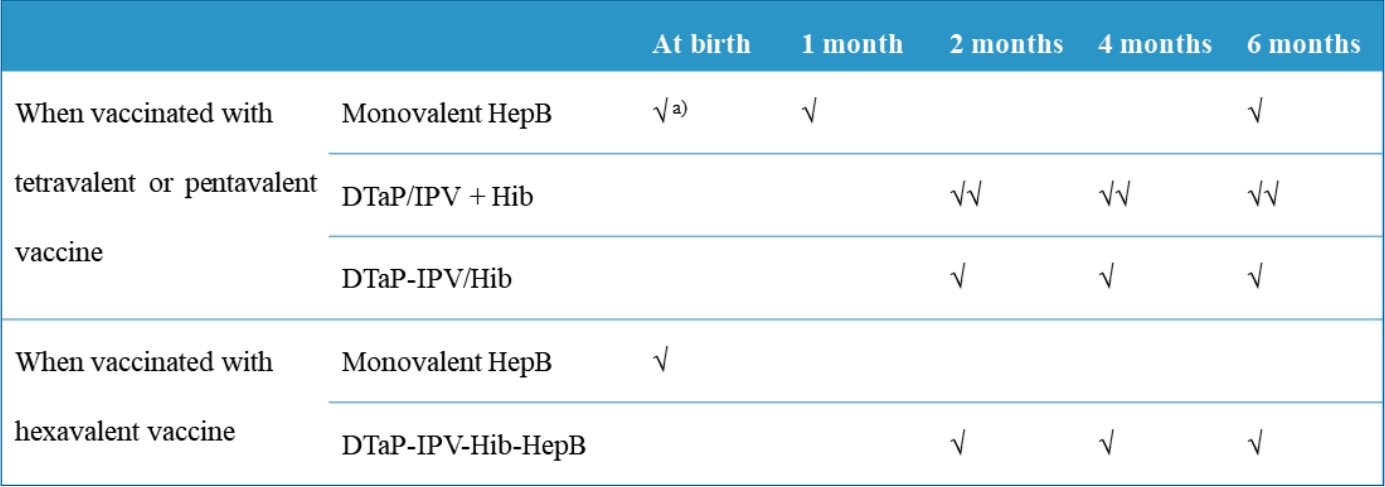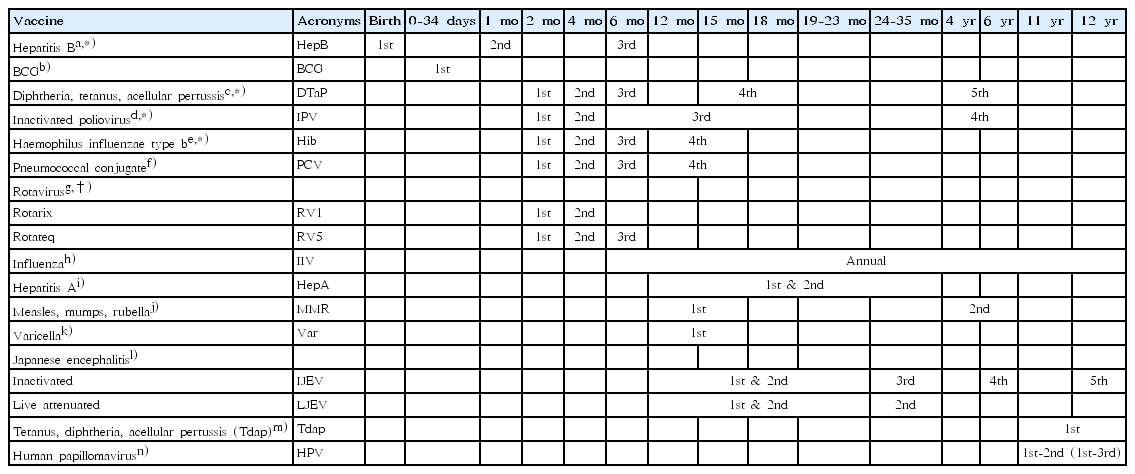Search
- Page Path
-
- HOME
- Search
- Review Article
- Infection
- Recommendation for use of diphtheria and tetanus toxoids and acellular pertussis, inactivated poliovirus, Haemophilus influenzae type b conjugate, and hepatitis B vaccine in infants
- Hye-Kyung Cho, Su Eun Park, Yae-Jean Kim, Dae Sun Jo, Yun-Kyung Kim, Byung-Wook Eun, Taek-Jin Lee, Jina Lee, Hyunju Lee, Ki Hwan Kim, Eun Young Cho, Jong Gyun Ahn, Eun Hwa Choi; The Committee on Infectious Diseases of the Korean Pediatric Society
- Clin Exp Pediatr. 2021;64(12):602-607. Published online June 8, 2021
-

∙ Diphtheria and tetanus toxoids and acellular pertussis-inactivated poliovirus-Haemophilus influenzae type b-hepatitis B (DTaP-IPV-Hib-HepB) was licensed in Korea in April 2020.
∙ DTaP-IPV-Hib-HepB is indicated as a 3-dose primary series for infants aged 2, 4, and 6 months who received the standalone HepB vaccine at birth.
∙ Infants born to HepB surface antigen-positive mothers are currently recommended to be immunized with HepB immunoglobulin at birth and then monovalent HepB vaccine at 0, 1, and 6 months.
- Recommended immunization schedule for children and adolescents: Committee on Infectious Diseases of the Korean Pediatric Society, 2018
- Eun Hwa Choi, Su Eun Park, Yae-Jean Kim, Dae Sun Jo, Yun-Kyung Kim, Byung-Wook Eun, Taek-Jin Lee, Jina Lee, Hyunju Lee, Ki Hwan Kim, Hye-Kyung Cho, Eun Young Cho, Jong-Hyun Kim
- Clin Exp Pediatr. 2019;62(7):252-256. Published online July 15, 2019
-

The Committee on Infectious Diseases of the Korean Pediatric Society recommended immunization schedule for children and adolescents aged 18 years or younger in the 9th (2018) edition of Immunization guideline. This report provides the revised recommendations made by the committee and summarizes several changes from the 2015 guideline. National immunization program (NIP) launched a human papillomavirus (HPV) immunization for girls...
- Infection
- Recommended immunization schedule for children and adolescents: Immunization Guideline (8th edition) released by the Korean Pediatric Society in 2015
- Jong-Hyun Kim, Eun Hwa Choi, Su Eun Park, Yae-Jean Kim, Dae Sun Jo, Yun-Kyung Kim, Byung-Wook Eun, Jina Lee, Soo-Young Lee, Hyunju Lee, Ki Hwan Kim, Kyung-Hyo Kim
- Clin Exp Pediatr. 2016;59(12):461-465. Published online December 31, 2016
-
This report includes the recommended immunization schedule table for children and adolescents based on the 8th (2015) and revised 7th (2012) Immunization Guidelines released by the Committee on Infectious Diseases of the Korean Pediatric Society (KPS). Notable revised recommendations include: reorganization of the immunization table with a list of vaccines on the vertical axis and the corresponding age on the...
- Case Report
- Rheumatology
- Recurrent macrophage activation syndrome since toddler age in an adolescent boy with HLA B27 positive juvenile ankylosing spondylitis
- Joon Hyeong Park, Yu Mi Seo, Seung Beom Han, Ki Hwan Kim, Jung Woo Rhim, Nack Gyun Chung, Myung Shin Kim, Jin Han Kang, Dae Chul Jeong
- Clin Exp Pediatr. 2016;59(10):421-424. Published online October 17, 2016
-
Recurrent macrophage activation syndrome (MAS) is very rare. We present the case of an adolescent boy with human leukocyte antigen (HLA) B27-positive ankylosing spondylitis (AS), who experienced episodes of recurrent MAS since he was a toddler. A 16-year-old boy was admitted because of remittent fever with pancytopenia and splenomegaly after surgical intervention for an intractable perianal abscess. He had been...
- DiGeorge syndrome who developed lymphoproliferative mediastinal mass
- Kyu Yeun Kim, Ji Ae Hur, Ki Hwan Kim, Yoon Jin Cha, Mi Jung Lee, Dong Soo Kim
- Clin Exp Pediatr. 2015;58(3):108-111. Published online March 20, 2015
-
DiGeorge syndrome is an immunodeficient disease associated with abnormal development of 3rd and 4th pharyngeal pouches. As a hemizygous deletion of chromosome 22q11.2 occurs, various clinical phenotypes are shown with a broad spectrum. Conotruncal cardiac anomalies, hypoplastic thymus, and hypocalcemia are the classic triad of DiGeorge syndrome. As this syndrome is characterized by hypoplastic or aplastic thymus, there are missing...
- Original Article
- Blood culture contamination in hospitalized pediatric patients: a single institution experience
- Hyewon Min, Cheong Soo Park, Dong Soo Kim, Ki Hwan Kim
- Clin Exp Pediatr. 2014;57(4):178-185. Published online April 30, 2014
-
Purpose Blood culture is the most important tool for detecting bacteremia in children with fever. However, blood culture contamination rates range from 0.6% to 6.0% in adults; rates for young children have been considered higher than these, although data are limited, especially in Korea. This study determined the contamination rate and risk factors in pediatric patients visiting the emergency room (ER)...
- Review Article
- Recommended immunization schedule for children and adolescents: the Korean Pediatric Society, 2013
- Dae Sun Jo, Jong-Hyun Kim, Eun Hwa Choi, Su Eun Park, Yae-Jean Kim, Yun Kyung Kim, Jina Lee, Byung Wook Eun, Soo Young Lee, Hyunju Lee, Ki Hwan Kim, Kyung-Hyo Kim
- Clin Exp Pediatr. 2013;56(6):231-234. Published online June 21, 2013
-
This article contains the recommended immunization schedule by the Committee on Infectious Diseases of the Korean Pediatric Society, updated in March 2013, when
Haemophilus influenzae type b vaccine is now included in the National Immunization Program in Korea. It also includes catch-up immunization schedule for children and adolescents who are behind the recommended schedule. These schedules are a minor revision...
- Original Article
- Enhanced detection and serotyping of
Streptococcus pneumoniae using multiplex polymerase chain reaction - Jong Gyun Ahn, Seong Yeol Choi, Dong Soo Kim, Ki Hwan Kim
- Clin Exp Pediatr. 2012;55(11):424-429. Published online November 23, 2012
-
Purpose Methods for quick and reliable detection of
Streptococcus pneumoniae are needed for the diagnosis of pneumococcal disease and vaccine studies. This study aimed to show that sequential multiplex polymerase chain reaction (PCR) is more efficient than conventional culture in achievingS. pneumoniae -positive results.Methods Nasopharyngeal (NP) secretions were obtained from 842 pediatric patients admitted with lower respiratory infections at Severance Children's Hospital...
- Review Article
- Juvenile idiopathic arthritis: Diagnosis and differential diagnosis
- Ki Hwan Kim, Dong Soo Kim
- Clin Exp Pediatr. 2010;53(11):931-935. Published online November 30, 2010
-
Juvenile idiopathic arthritis (JIA) is comprised of a heterogeneous group of several disease subtypes that are characterized by the onset of arthritis before the age of 16 years and has symptoms lasting at least 6 weeks. The previous classification of JIA included seven different categories, whereas its current classification was compiled by the International League of the Association for Rheumatology,...
- Case Report
- A case of postoperative nasopharyngeal reflux associated with retropharyngeal lymphangioma in newborn infant
- Ah Reum Kwon, Eun Jung Park, Ki Hwan Kim, Dong Soo Kim
- Clin Exp Pediatr. 2010;53(2):262-266. Published online February 15, 2010
-
Tumor necrosis factor-α (TNF-α) is a major proinflammatory cytokine involved in the pathophysiology of juvenile rheumatoid arthritis. Etanercept is an effective inhibitor of TNF-α and has shown a beneficial effect in patients with JRA. However, the most important cause of concern related to etanercept administration is infection. We report a case of encephalitis in a JRA patient receiving long-term treatment... -
- Original Article
- Comparison of a whole blood Interferon-γ assay and A tuberculin skin test for detecting latent tuberculosis infection in children
- Jin-Kyong Chun, Jin-Kyong Chun, Chang Ki Kim, Chang Ki Kim, Hyun Sook Kim, Hyun Sook Kim, Ghee Young Jung, Ghee Young Jung, John A. Linton, John A. Linton, Ki Hwan Kim, Ki Hwan Kim, Taek Jin Lee, Taek Jin Lee, Ji Hyun Jeon, Ji Hyun Jeon, Dong Soo Kim, Dong Soo Kim
- Clin Exp Pediatr. 2008;51(9):971-976. Published online September 15, 2008
-
Purpose : Surveillance for detecting and managing latent tuberculosis infection (LTBI) is a key component of tuberculosis control. The classic surveillance tool, the tuberculin skin test (TST), may have some limitations when used in the Bacillus Calmette-Guérin (BCG)-vaccinated population. The object was to perform a blood test QuantiFERON®-TB Gold In Tube (QFT-G IT) based on the detection of interferon-γ (IFN-γ)... -
- Clinical characteristics and prognostic factors for survival in hemophagocytic lymphohistiocytosis
- Khi Joo Kim, Ki Hwan Kim, Taek Jin Lee, Jin-Kyong Chun, Chuhl Joo Lyu, Dong Soo Kim
- Clin Exp Pediatr. 2008;51(3):299-306. Published online March 15, 2008
-
Purpose : Hemophagocytic lymphohistiocytosis (HLH) is a rare but fatal disorder characterized by fever, splenomegaly, pancytopenia, and hemophagocytosis in the bone marrow and other tissues. In this study, we investigated the clinical manifestations and prognostic factors in patients with HLH. Methods : We retrospectively analyzed the data from 29 patients who were diagnosed whit HLH in the Severance Children's Hospital from... -
- Case Report
- Pyridoxine responsive sideroblastic anemia in a boy with mitral valve prolapse
- June Seung Sung, Ki Hwan Kim, Dong Gyun Han, Mi Jeong Kim, Young Kook Cho, Hae Yul Chung, Hee Jo Baek, Jae Sook Ma, Hoon Kook, Tai Ju Hwang
- Clin Exp Pediatr. 2006;49(11):1223-1226. Published online November 15, 2006
-
Sideroblastic anemia is a rare, heterogeneous group of disorders characterized by hyperferremia, microcytic hypochromic anemia, and bone marrow erythroid hyperplasia with the presence of numerous ringed sideroblasts. We describe herewith the case of a rare coincidence of sideroblastic anemia and mitral valve prolapse with resultant regurgitation in a 2-year-old boy. In addition to the inherent propensity for the development of... -
-

-
-

-

-
Impact Factor3.2
-
8.02023CiteScore94nd percentilePowered by







